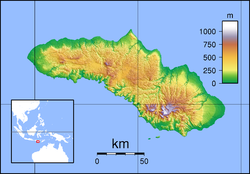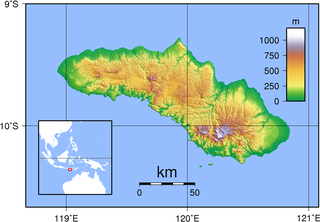
Sumba is an island in eastern Indonesia. It is one of the Lesser Sunda Islands and is in the province of East Nusa Tenggara. Sumba has an area of 11,006.62 square kilometres, and the population was 779,049 at the 2020 Census. To the northwest of Sumba is Sumbawa, to the northeast, across the Sumba Strait, is Flores, to the east, across the Savu Sea, is Timor, and to the south, across part of the Indian Ocean, is Australia.

Wallacea is a biogeographical designation for a group of mainly Indonesian islands separated by deep-water straits from the Asian and Australian continental shelves. Wallacea includes Sulawesi, the largest island in the group, as well as Lombok, Sumbawa, Flores, Sumba, Timor, Halmahera, Buru, Seram, and many smaller islands. The islands of Wallacea lie between the Sunda Shelf to the west, and the Sahul Shelf including Australia and New Guinea to the south and east. The total land area of Wallacea is 347,000 km2 (134,000 sq mi).

The yellow-crested cockatoo also known as the lesser sulphur-crested cockatoo, is a medium-sized cockatoo with white plumage, bluish-white bare orbital skin, grey feet, a black bill, and a retractile yellow or orange crest. The sexes are similar.

Siberut National Park comprises 1,905 km2 (47%) of the island of Siberut in the Mentawai Islands of West Sumatra, Indonesia. The whole island including the national park is part of the World Network of Biosphere Reserves.
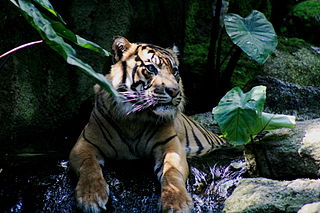
The fauna of Indonesia is characterised by high levels of biodiversity and endemicity due to its distribution over a vast tropical archipelago. Indonesia divides into two ecological regions; western Indonesia which is more influenced by Asian fauna, and the east which is more influenced by Australasian species.

The Sumba hornbill is a large bird in the Bucerotidae, or hornbill family. The scientific name commemorates British colonial administrator and zoological collector Alfred Hart Everett.
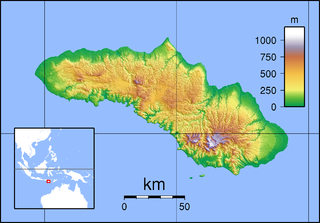
Laiwangi Wanggameti National Park is located on the island of Sumba in Indonesia. All forests types that exist on this island can be found in this national park. Some endemic plant species are protected in this national park, such as Syzygium species, Alstonia scholaris, Ficus species, Canarium oleosum, Cinnamomum zeylanicum, Myristica littoralis, Toona sureni, Sterculia foetida, Schleichera oleosa, and Palaquium obovatum.
The little Sumba hawk-owl, also known as the little Sumba boobook or least boobook, is a species of owl in the family Strigidae. It is endemic to the Indonesian island of Sumba. Its natural habitat is subtropical or tropical moist lowland forests. It is threatened by habitat loss.

The Sumba green pigeon is a species of bird in the family Columbidae. It is endemic to Sumba Island in Indonesia. Its natural habitat is subtropical or tropical moist lowland forests. It is threatened by habitat loss.

The Sumba buttonquail is a species of bird in the family Turnicidae. The scientific name commemorates British colonial administrator and zoological collector Alfred Hart Everett.
The Sumba myzomela is a species of bird in the family Meliphagidae. It is endemic to Sumba in the western Lesser Sunda Islands of Indonesia, where it is found in forest with a significant component of deciduous trees.
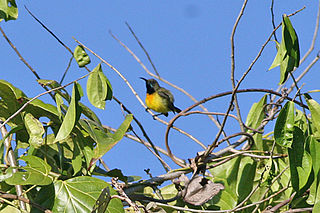
The apricot-breasted sunbird is a species of bird in the family Nectariniidae. It is endemic to the island of Sumba in Indonesia, where its natural habitats are subtropical or tropical moist lowland forests and subtropical or tropical moist montane forests. Although it is quite common, very little is known about its biology, with virtually nothing known about its breeding or diet.

The elegant pitta is a species of passerine bird in the pitta family Pittidae. It is endemic to Indonesia, where it is found in the Lesser Sunda Islands and Moluccas.

The marigold lorikeet or Sumba lorikeet is a species of parrot that is endemic to the south-east Asian islands of Sumba, Rote, Wetar and Kisar (Indonesia) and Timor. It was previously considered a subspecies of the rainbow lorikeet, but following a review in 1997, it is increasingly treated as a separate species.
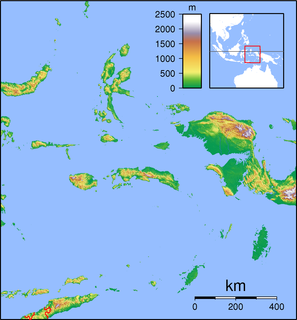
Manusela National Park is located on Seram island, in the Maluku archipelago of Indonesia. It is made up of coastal forest, swamp forest, lowland and montane rainforest ecosystem types. Mount Binaiya at 3,027 meters, is the highest of the park's six mountains. Seram is remarkable for its high degree of localised bird endemism. The park also includes important karst landscapes. On Mount Hatu Saka, near the coast of Saleman-Sawai, it is the Goa Hatusaka, currently the deepest cave of the whole Indonesia.

The Lesser Sundas deciduous forests is a tropical dry forest ecoregion in Indonesia. The ecoregion includes the islands of Lombok, Sumbawa, Komodo, Flores, and Alor, along with the many adjacent smaller islands.

Aketajawe-Lolobata National Park is a national park on Halmahera, the biggest island in the North Maluku province of Indonesia. The park is considered by BirdLife International to be vital for the survival of at least 23 endemic bird species. Aketajawe-Lolobata, which has an area of 167,300 hectares, was declared a national park in 2004.

The Lesser Sunda Islands are an archipelago in Maritime Southeast Asia, north of Australia. Together with the Greater Sunda Islands to the west they make up the Sunda Islands. The islands are part of a volcanic arc, the Sunda Arc, formed by subduction along the Sunda Trench in the Java Sea.

Wanokaka River is a river in Sumba island, Province of East Nusa Tenggara, Indonesia. It is located a few kilometers south of Waikabubak, with the District of Wanokaka (Wanukaka), east of the District of Lamboya.

